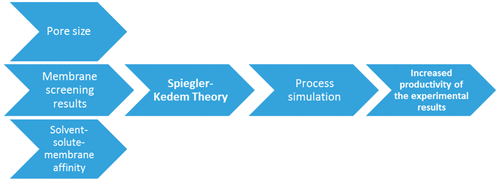当前位置:
X-MOL 学术
›
Org. Process Res. Dev.
›
论文详情
Our official English website, www.x-mol.net, welcomes your
feedback! (Note: you will need to create a separate account there.)
From Reaction Solvent to Crystallization Solvent, Membrane Assisted Reaction Workup and Interpretation of Membrane Performance Results by Application of Spiegler–Kedem Theory
Organic Process Research & Development ( IF 3.1 ) Pub Date : 2017-12-07 00:00:00 , DOI: 10.1021/acs.oprd.7b00210 Dominic Ormerod 1 , Anita Buekenhoudt 1 , Bas Bongers 1 , Todor Baramov 2 , Jorma Hassfeld 2
Organic Process Research & Development ( IF 3.1 ) Pub Date : 2017-12-07 00:00:00 , DOI: 10.1021/acs.oprd.7b00210 Dominic Ormerod 1 , Anita Buekenhoudt 1 , Bas Bongers 1 , Todor Baramov 2 , Jorma Hassfeld 2
Affiliation

|
Within practically all multistep synthetic sequences used to prepare molecular entities, a step can be found in which a change of solvent is required. Presently this is nearly always carried out by distillation process. Alternatives to distillation do, however, exist such as the nonthermal membrane based solvent exchange. Although highly efficient and useful in several circumstances, this technique is seldom carried out within an industrial setting, possibly due to some uncertainty as to the issues to be confronted. By making use of a practical example in which the Refametnib intermediate DIM-DAB (2) undergoes a solvent exchange from the reaction solvent THF to its crystallization solvent ethanol, these issues are illustrated and explained. Furthermore, the at first sight seemingly arbitrary rejection profile of DIM-DAB (2) over various membranes is explained by applying Spiegler–Kedem theory. Use of this modeling leads to a more targeted membrane screening phase, in which solute rejection is determined in a particular solvent over a number of membranes. Moreover, this model can also be used to simulate membrane performance in a solvent exchange without necessarily requiring the experimental demonstration. The simulation increases the efficiency of the experimental work by allowing a more comprehensive view of membrane performance. This in turn leads to more informed decisions of which membrane is the most suited to the requirements of the process.
中文翻译:

从反应溶剂到结晶溶剂,膜辅助反应后处理和Spiegler–Kedem理论的膜性能结果解释
在几乎所有用于制备分子实体的多步合成序列中,都可以找到需要更换溶剂的步骤。目前,这几乎总是通过蒸馏过程进行的。但是,确实存在蒸馏的替代方法,例如基于非热膜的溶剂交换。尽管在某些情况下非常高效且有用,但是这种技术很少在工业环境中进行,这可能是由于要面对的问题存在一些不确定性。通过使用Refametnib中间体DIM-DAB(2)经历从反应溶剂THF到其结晶溶剂乙醇的溶剂交换,这些问题已得到说明和解释。此外,乍看之下DIM-DAB的拒绝特性(2)通过应用Spiegler–Kedem理论来解释各种膜上的情况。使用该模型可导致更具针对性的膜筛选阶段,在该阶段中,在多种膜上的特定溶剂中确定溶质截留率。此外,该模型还可以用于模拟溶剂交换中的膜性能,而无需进行实验演示。通过允许更全面地查看膜性能,模拟提高了实验工作的效率。这进而导致更明智的决定,即哪种膜最适合该过程的要求。
更新日期:2017-12-07
中文翻译:

从反应溶剂到结晶溶剂,膜辅助反应后处理和Spiegler–Kedem理论的膜性能结果解释
在几乎所有用于制备分子实体的多步合成序列中,都可以找到需要更换溶剂的步骤。目前,这几乎总是通过蒸馏过程进行的。但是,确实存在蒸馏的替代方法,例如基于非热膜的溶剂交换。尽管在某些情况下非常高效且有用,但是这种技术很少在工业环境中进行,这可能是由于要面对的问题存在一些不确定性。通过使用Refametnib中间体DIM-DAB(2)经历从反应溶剂THF到其结晶溶剂乙醇的溶剂交换,这些问题已得到说明和解释。此外,乍看之下DIM-DAB的拒绝特性(2)通过应用Spiegler–Kedem理论来解释各种膜上的情况。使用该模型可导致更具针对性的膜筛选阶段,在该阶段中,在多种膜上的特定溶剂中确定溶质截留率。此外,该模型还可以用于模拟溶剂交换中的膜性能,而无需进行实验演示。通过允许更全面地查看膜性能,模拟提高了实验工作的效率。这进而导致更明智的决定,即哪种膜最适合该过程的要求。











































 京公网安备 11010802027423号
京公网安备 11010802027423号